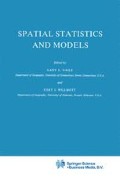Abstract
The gravity model has been by far the most popular mathematical description of human spatial interaction. The purpose of this paper is not to review its usage in general (Carrothers, 1956; Tocalis, 1978), but only to discuss one statistical question; the difficulties associated with accurately estimating the tendency of trips to decrease as distance increases by use of ordinary least squares (OLS) regression models applied to observed data. This introductory section will outline the nature of the problem and of the debate that has developed in the last ten years.
Access this chapter
Tax calculation will be finalised at checkout
Purchases are for personal use only
Preview
Unable to display preview. Download preview PDF.
Bibliography
Baxter, M.: 1983, ‘Model mis-specification and spatial structure in spatial interaction models’, Environment and Planning A 15, 319–28.
Carroll, J. D. and H. W. Bevis: 1957, ‘Predicting local travel in urban regions’, Papers of the Regional Science Association 3, 183–197.
Carrothers, G. A. P.: 1956, ‘An historical review of the gravity and potential concepts of human interaction’, Journal of the American Institute of Planners 22, 94–102.
Cliff, A. D., R. Martin, and J. K. Ord: 1974, ‘Evaluating the friction of distance para-meter in gravity models’, Regional Studies 8, 281–286.
Cliff, A. D., R. Martin, and J. K. Ord: 1975, ‘Map pattern and friction of distance parameters: reply to comments by R. J. Johnston, and by L. Curry, D. A. Griffith and E. S. Sheppard’, Regional Studies 9, 285–288.
Cliff, A. D., R. Martin, and J. K. Ord: 1976, ‘A reply to the final comment’, Regional Studies 10, 341–342.
Curry, L.: 1972, ‘A spatial analysis of gravity flows’, Regional Studies 6, 131–147.
Curry, L., D. A. Griffith, and E. S. Sheppard: 1975, ‘Those gravity parameters again’, Regional Studies 9, 289–296.
Fotheringham, A. S.: 1980, Spatial Structure, Spatial Interaction and Distance-Decay Parameters, Unpublished Ph. D. Dissertation, McMaster University, Hamilton.
Fotheringham, A. S. and M. J. Webber: 1980, ‘Spatial structure and the parameters of spatial interaction models’, Geographical Analysis 12, 33–46.
Glickman, N. J.: 1976, ‘A note on simultaneous equation estimation techniques: Application with a regional econometric model’, Regional Science and Urban Economics 6, 275–288.
Gould, P.: 1975, ‘Acquiring spatial information’, Economic Geography 51, 87–99. Hepple, L. W.: 1976, ‘A maximum likelihood model for econometric estimation with
spatial series’, in I. Masser (ed.), Theory and Practice in Regional Science,London Papers in Regional Science, vol. 6, Pion, London.
Johnston, J.: 1972, Econometric Methods 2nd ed., McGraw-Hill, New York.
Johnston, R. J.: 1973, ‘On frictions of distance and regression coefficients’, Area 5, 187–191.
Johnston, R. J.: 1975a, ‘Map pattern and friction of distance parameters: A comment’, Regional Studies 9, 281–283.
Johnston, R. J.: 1975b, The World Trade System: Some Enquiries into its Spatial Structure, G. Bell & Sons, London.
Johnston, R. J.: 1976, ‘On regression coefficients in comparative studies of the friction of distance’, Tijdschrift voor economische en sociale geografie 67, 15–28.
Johnston, R. J.: 1978, Multivariate Statistical Analysis in Geography, Longman, New
York.
Koutsoyiannis, A.: 1978, Theory of Econometrics: An Introductory Exposition of Econometric Methods, Barnes and Noble, New York.
Leinbach, T. R.: 1973, ‘Distance, information flows and modernisation: some observations from West Malaysia’, The Professional Geographer 25, 7–11.
Meyer, D. R.: 1974, ‘Use of two stage least squares to solve simultaneous equation systems in geography’, in M. Yeates (eds.), Proceedings of the 1972 Meeting of the I.G.U. Commission on Quantitative Geography,McGill-Queen’s University Press, Montreal, pp. 101–112.
Olsson, G.: 1970, ‘Explanation, prediction and meaning variance: an assessment of distance interaction models’, Economic Geography 46, 223–233.
O’Sullivan, P. M.: 1971, ‘Forecasting interregional freight flows in Great Britain’, in M. D. I. Chisholm, A. E. Frey, and P. Haggett (eds.), Regional Forecasting, Butterworth, London, pp. 443–450.
O’Sullivan, P. M.: 1977, ‘On gravity and eruptions’, The Professional Geographer 29, 182–185.
Porter, R.: 1956, ‘Approach to migration through its mechanism’, Geografiska Annaler 38, 13–45.
Sheppard, E. S.: 1978, ‘Theoretical underpinnings of the gravity hypothesis’, Geographical Analysis 10, 386–402.
Sheppard, E. S.: 1979a. S.: 1979a, ‘Gravity parameter estimation’, Geographical Analysis 11, 12 1132.
Sheppard, E. S.: 1979b, ‘Notes on spatial interaction’, The Professional Geographer 31, 8–15.
Sheppard, E. S.: 1980, ‘he ideology of spatial choice’, Papers of the Regional Science Association 45, 197–213.
Sheppard, E. S., D. A. Griffith, and L. Curry: 1976, ‘A final comment on mis-specifica-tion and autocorrelation in those gravity parameters’, Regional Studies 10, 337–339. Stetzer, F. and A. G. Phipps: 1977, ‘Spatial choice theory and spatial indifference: a comment’, Geographical Analysis 9, 400–403.
Tocalis, T. R.: 1978, ‘Changing theoretical foundations of the gravity concept of human interaction’, in B. J. L. Berry (ed.), Perspectives in Geography 3.• The Nature of Change in Geographical Ideas,Northern Illinois University Press, DeKalb.
Author information
Authors and Affiliations
Editor information
Editors and Affiliations
Rights and permissions
Copyright information
© 1984 Springer Science+Business Media Dordrecht
About this chapter
Cite this chapter
Sheppard, E.S. (1984). The Distance-Decay Gravity Model Debate. In: Gaile, G.L., Willmott, C.J. (eds) Spatial Statistics and Models. Theory and Decision Library, vol 40. Springer, Dordrecht. https://doi.org/10.1007/978-94-017-3048-8_20
Download citation
DOI: https://doi.org/10.1007/978-94-017-3048-8_20
Publisher Name: Springer, Dordrecht
Print ISBN: 978-90-481-8385-2
Online ISBN: 978-94-017-3048-8
eBook Packages: Springer Book Archive

